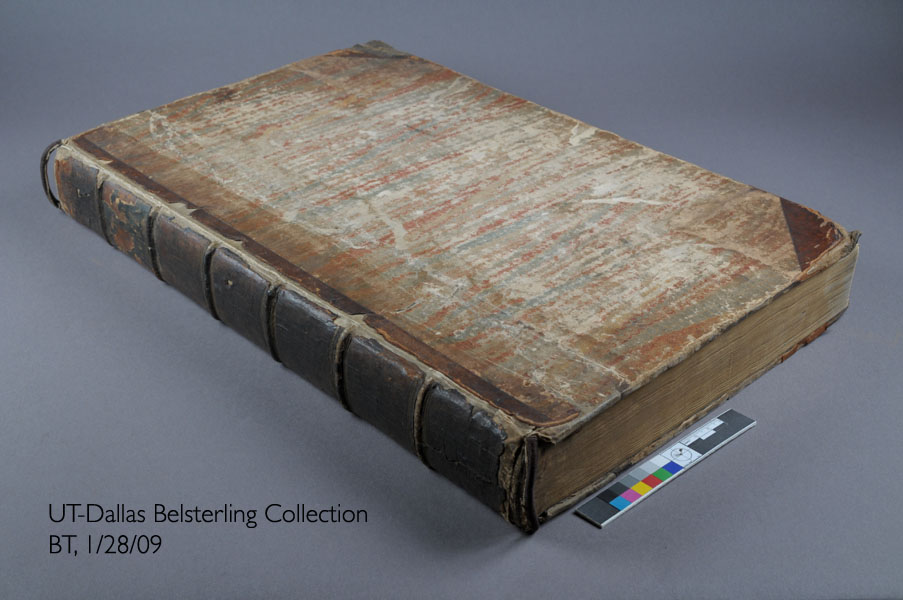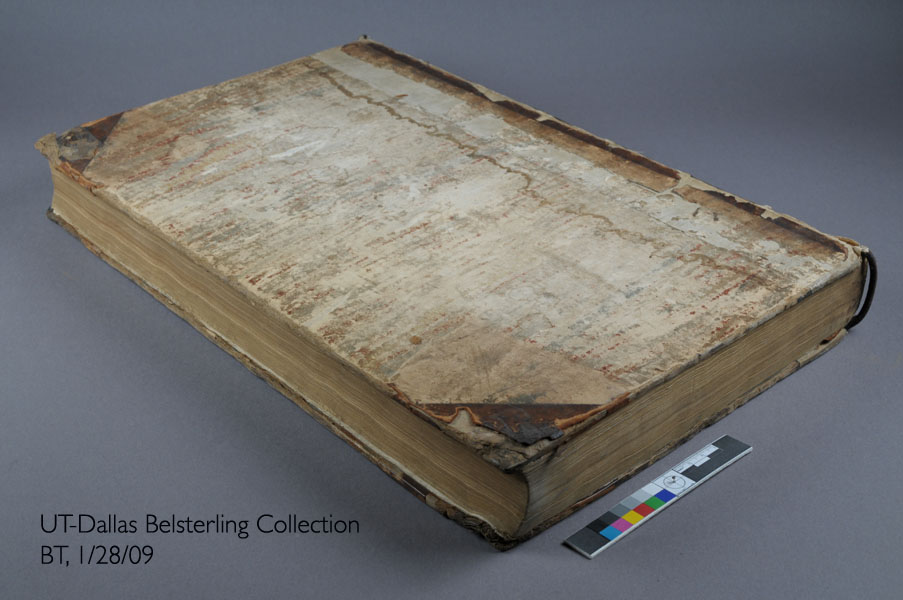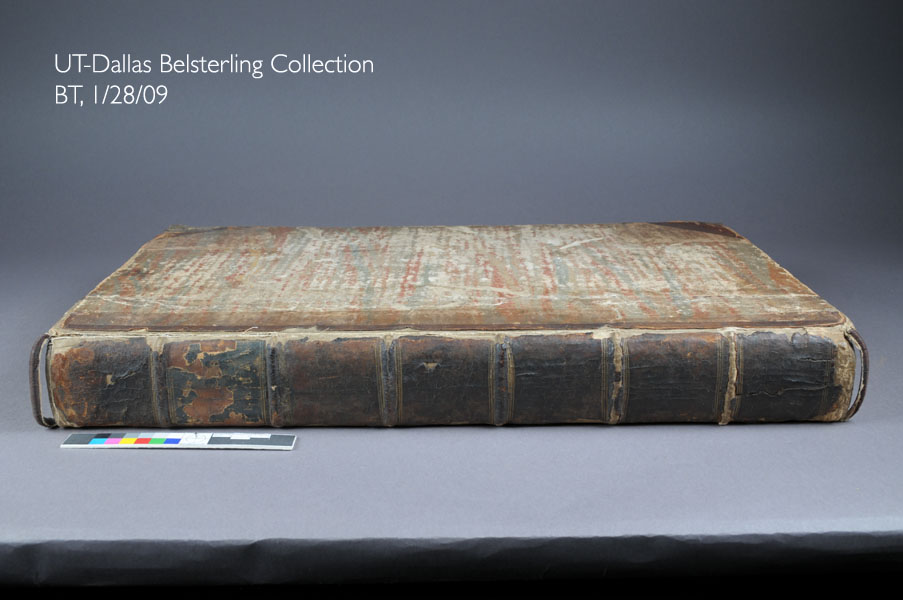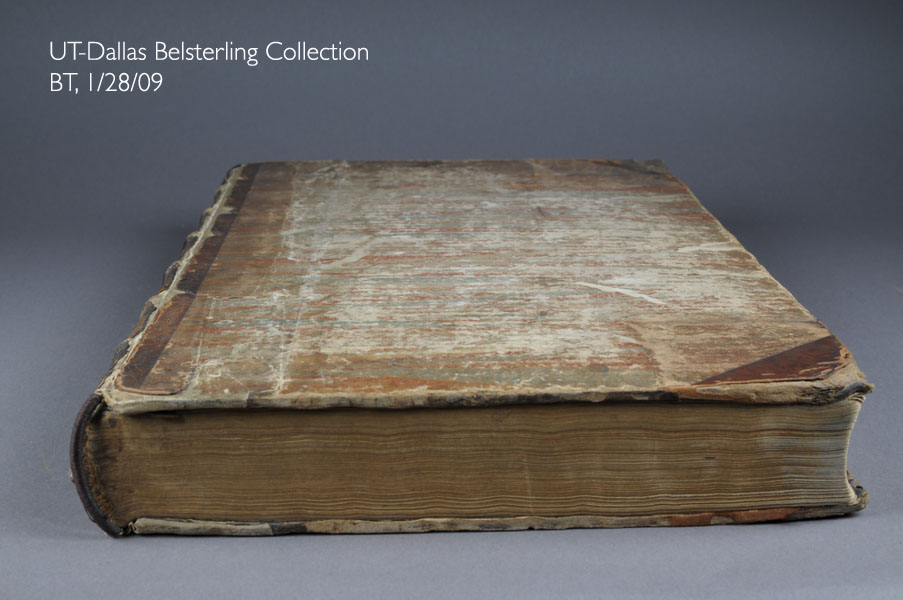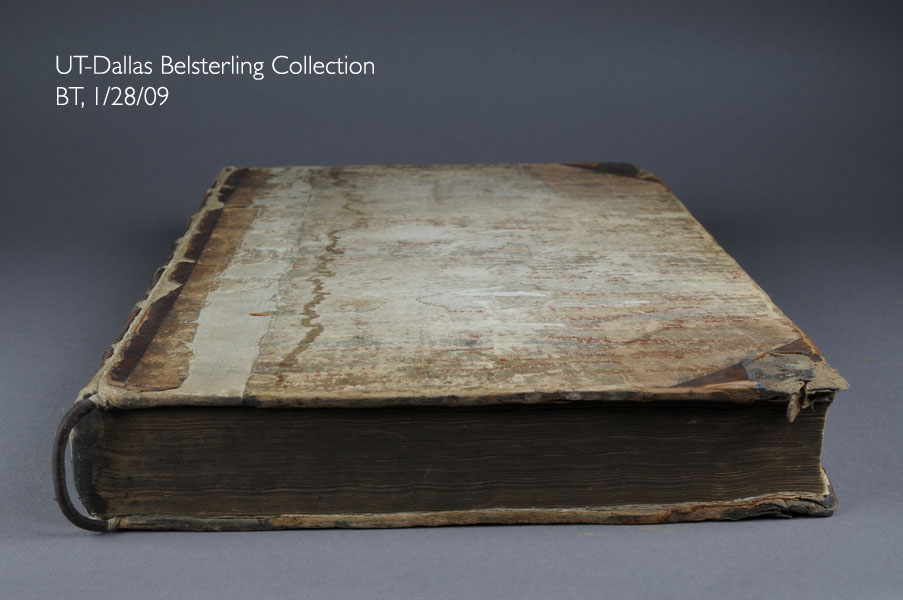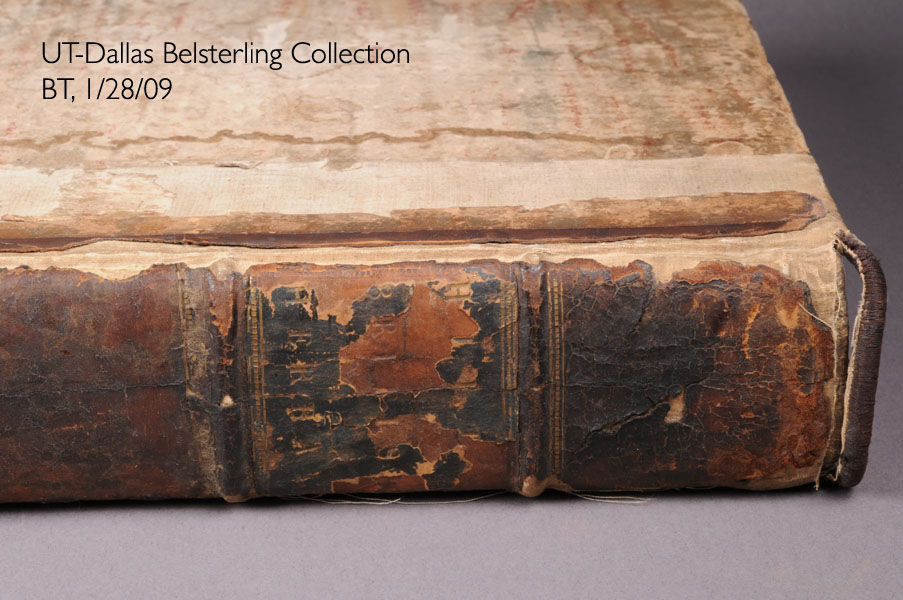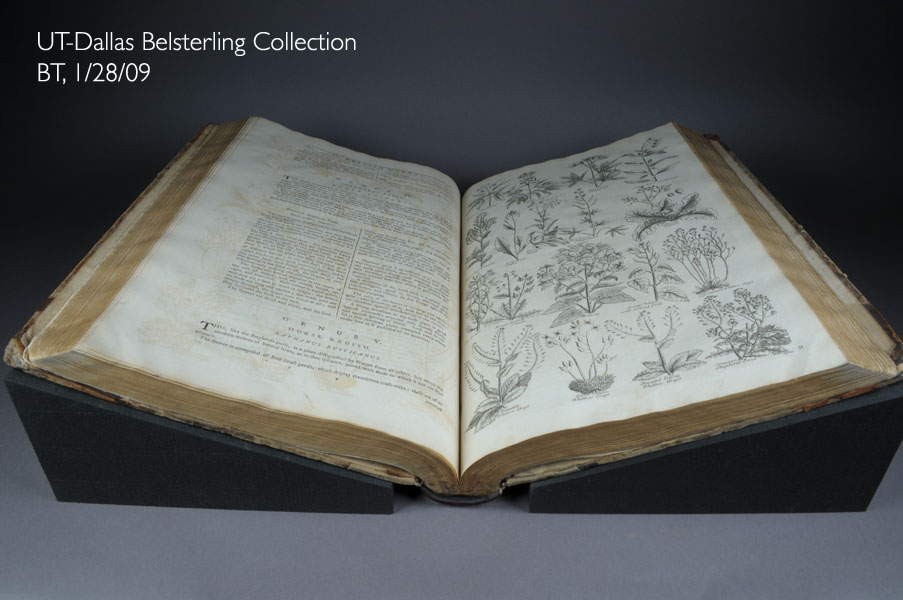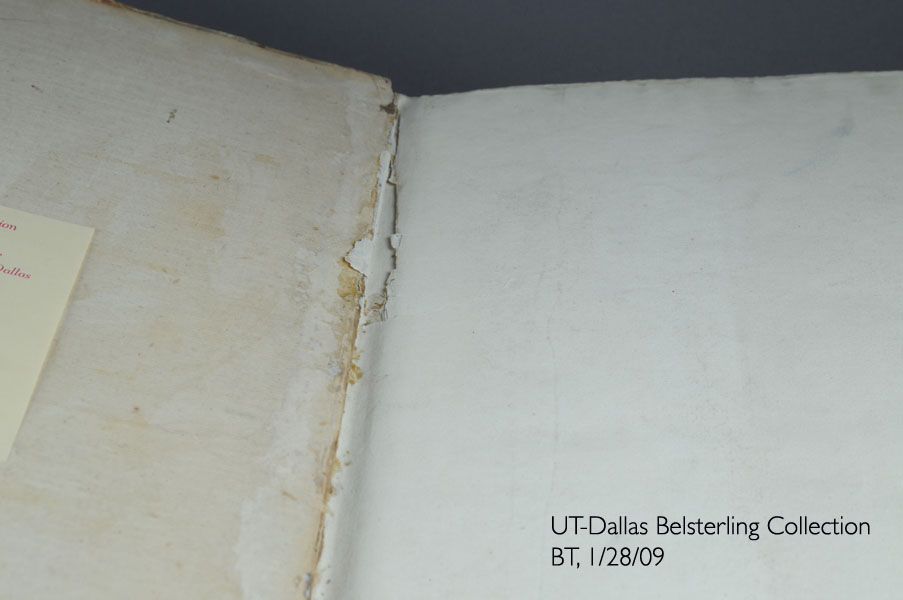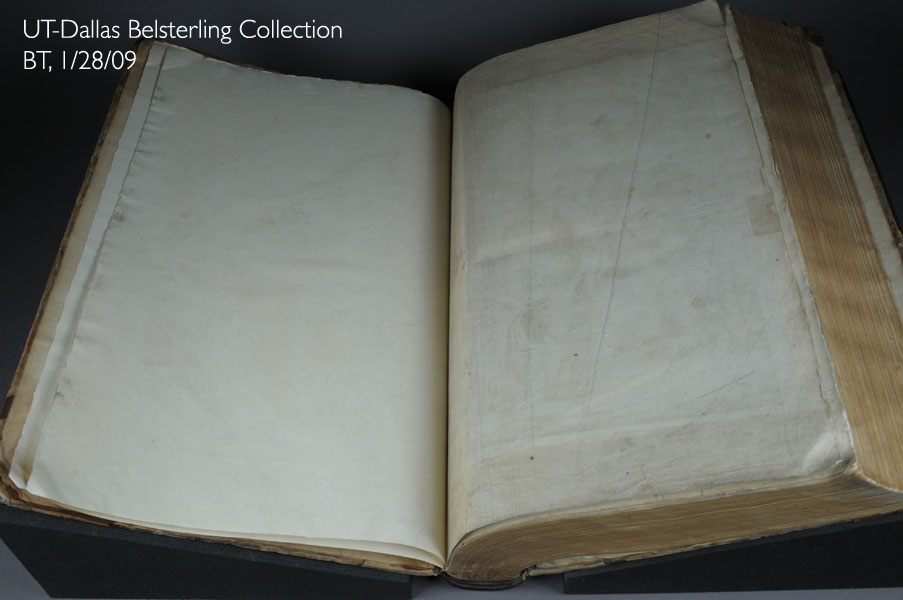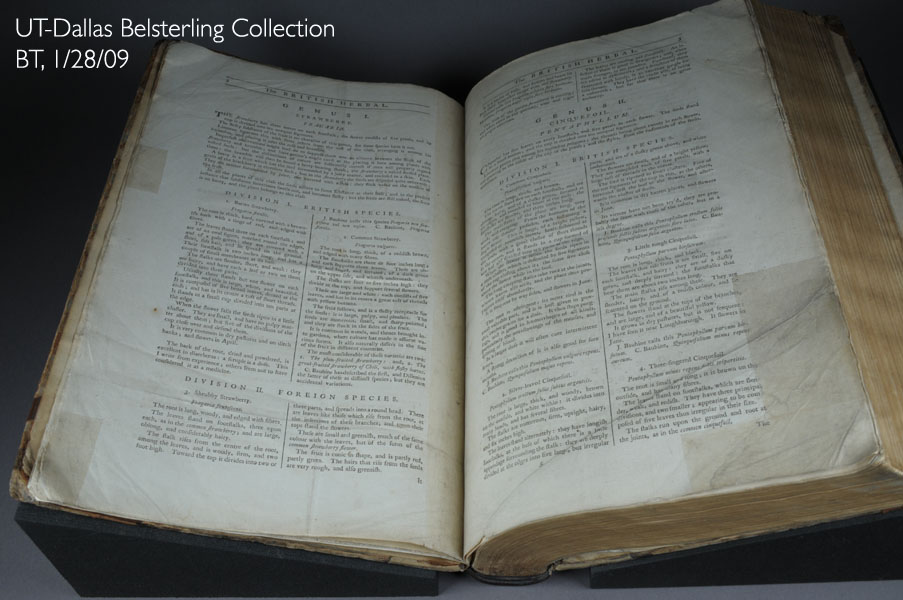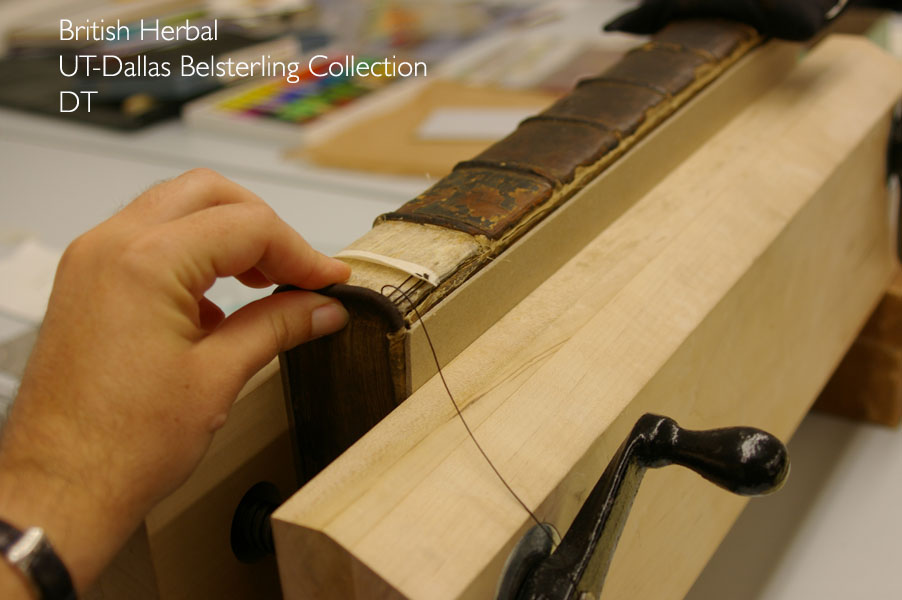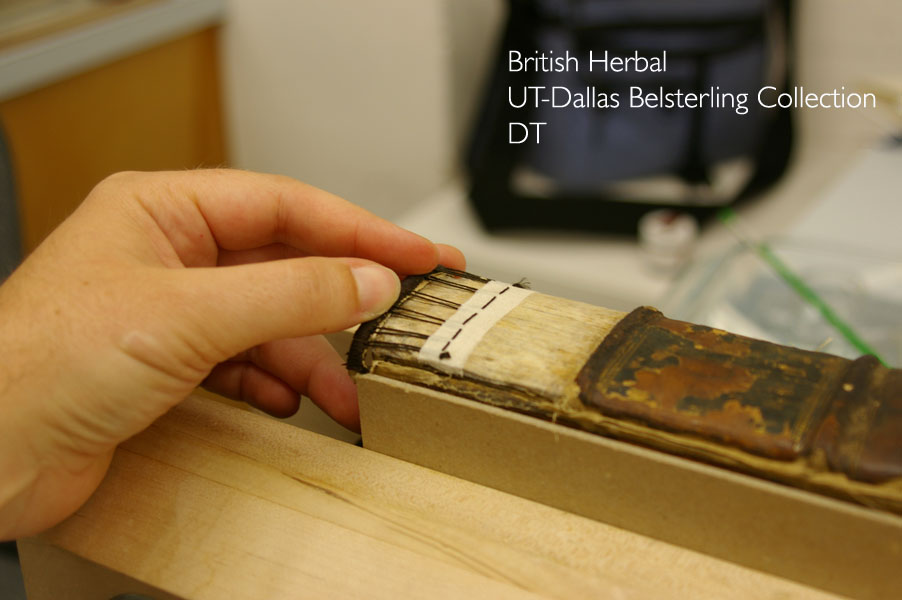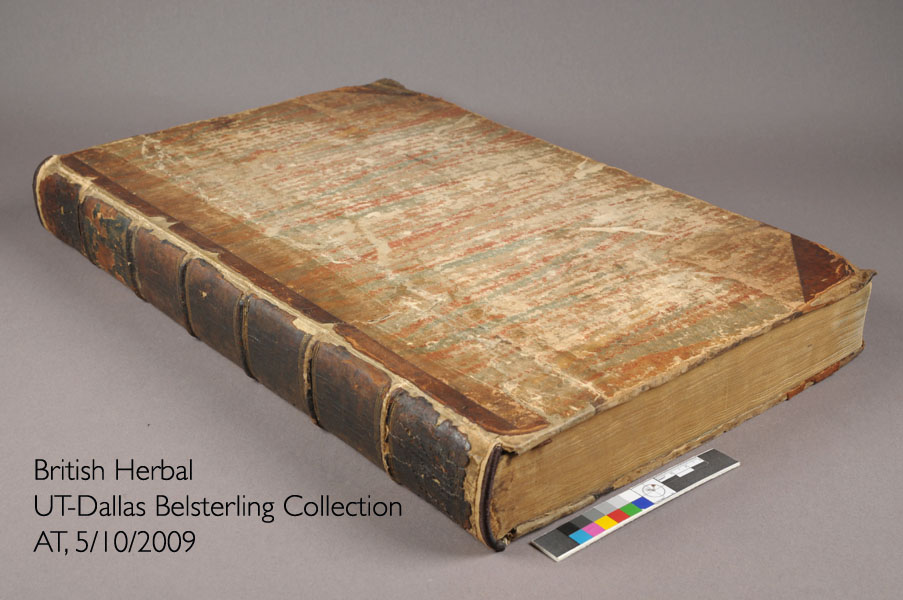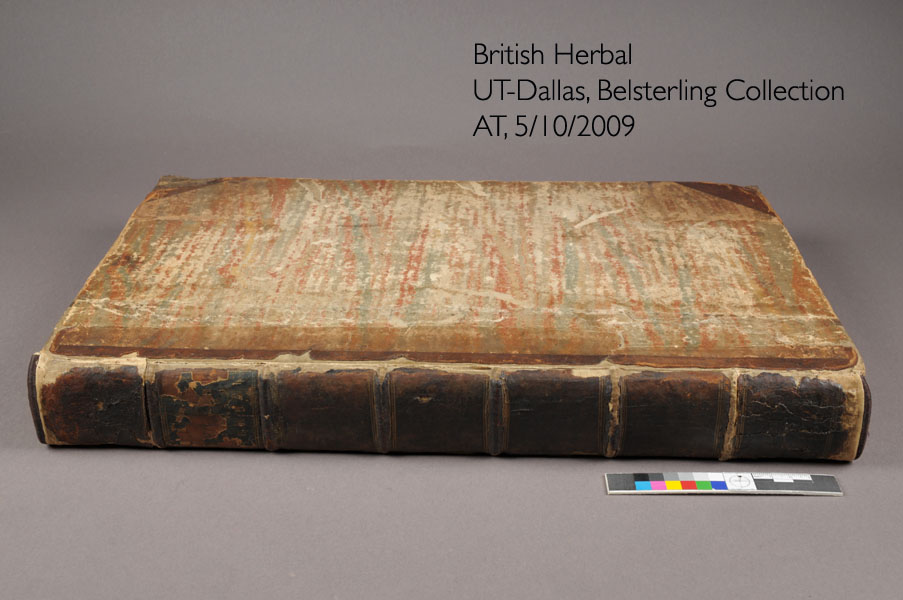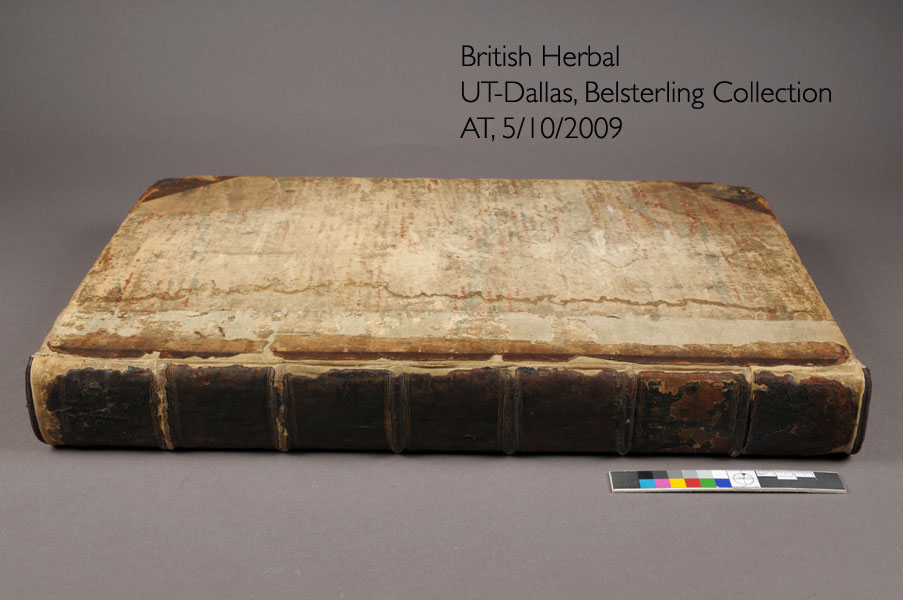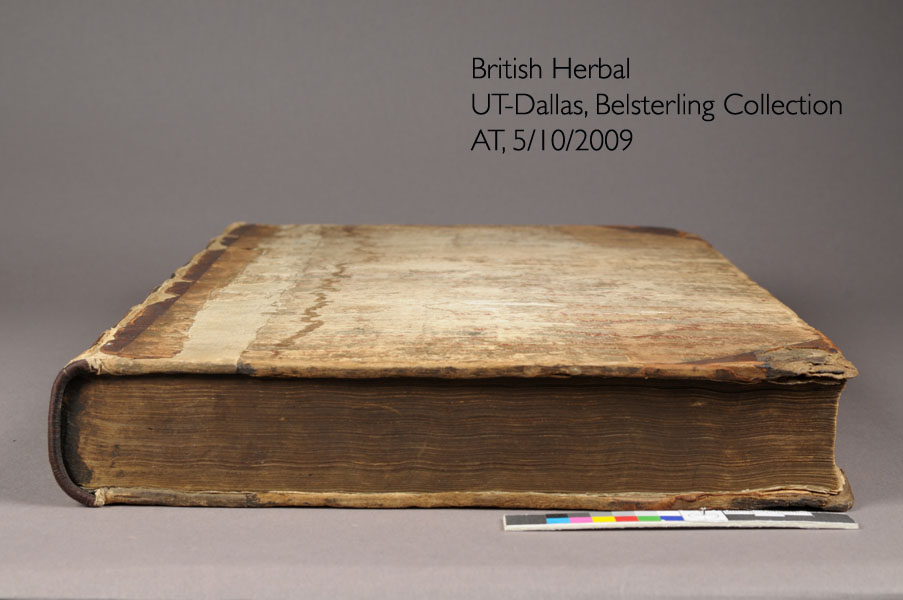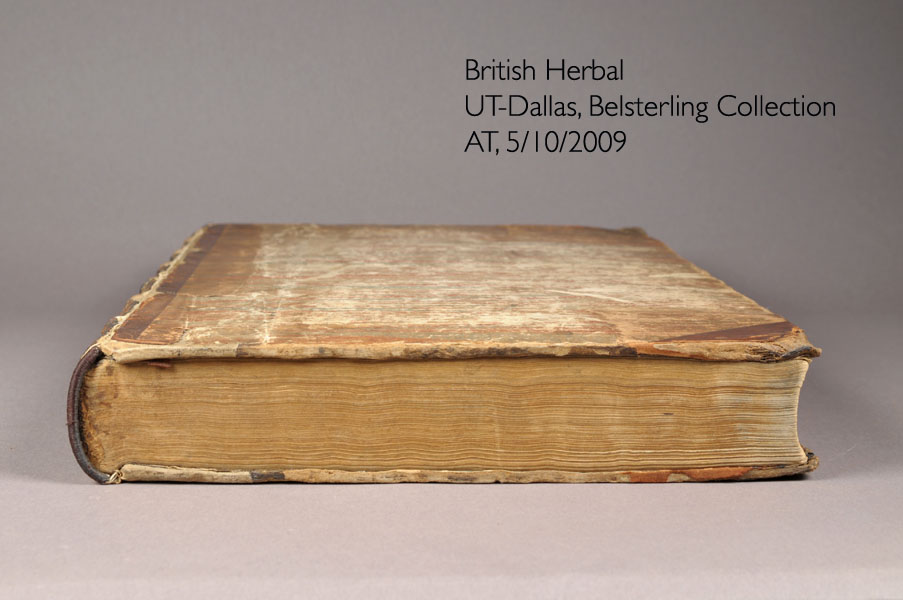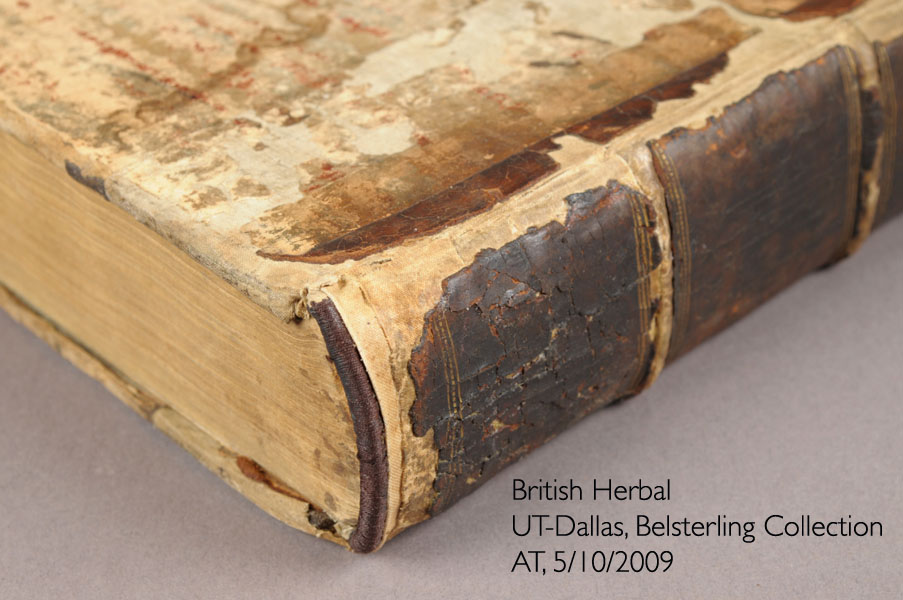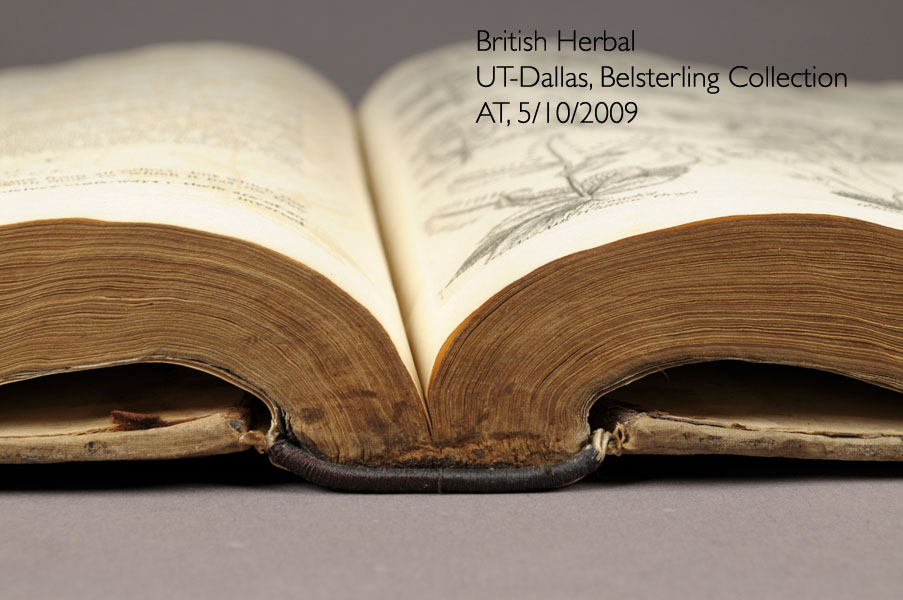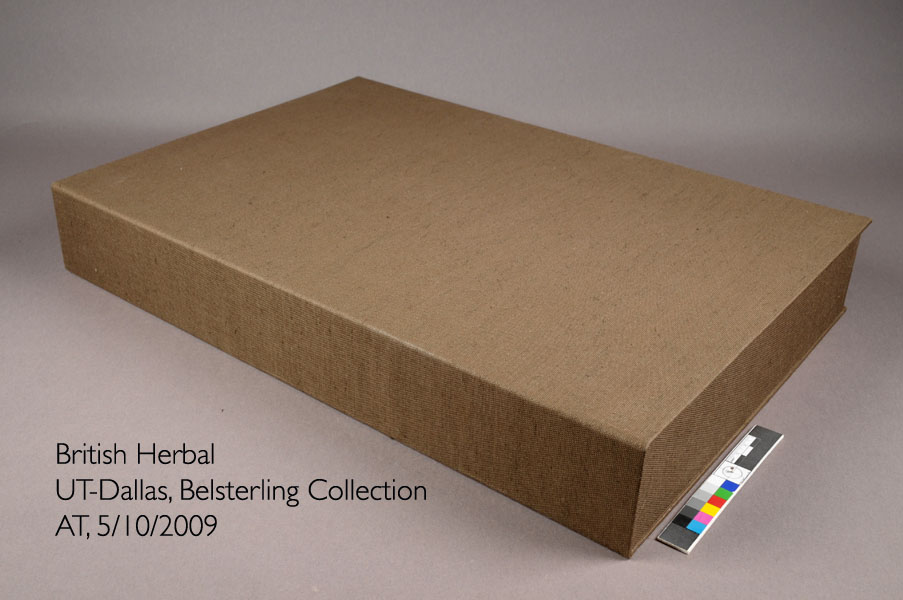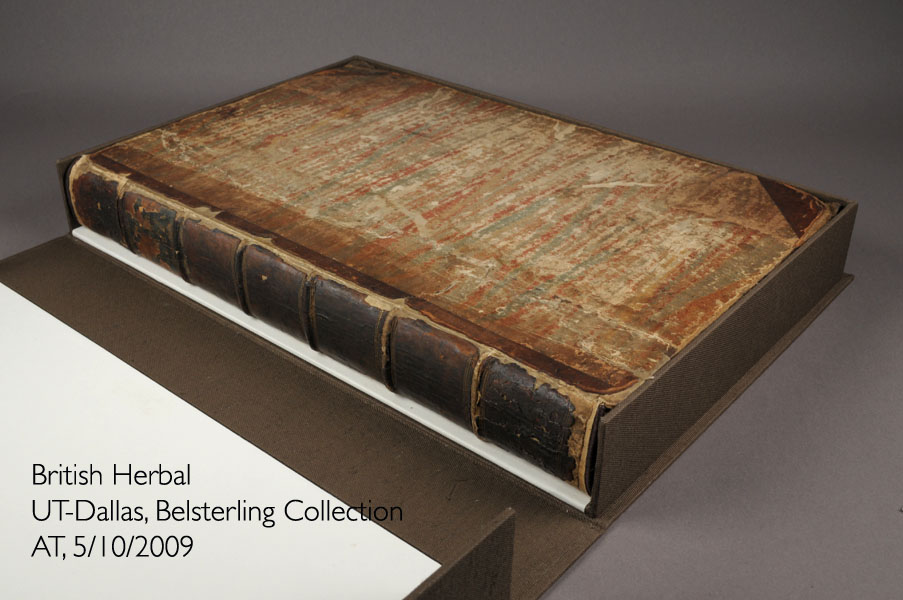Book Treatments
The British Herbal
Board Attachment and Endband Reinforcement
Photo Documention
- Before
- During
- After
Click thumbnails to view images.
Treatment Report
PCS#: 08-139
ACCESSION OR CALL#: UT-Dallas McDermott Library, Louise B. Belsterling Botanical Collection, Closed Stacks Bels QK41.H6
Author: Hill, John, M.D.
Title: The British Herbal: An History of Plants and Trees, Natives of Britain, Cultivated for Use, or Raised for Beauty
Imprint: London, 1756, 1st Edition, Folio. Printed for T. Osborne and J. Shipton, in Gray’s Inn; J. Hodges, near London-Bridge; J. Newberry, in St. Paul’s Church-Yard; B. Collins; And S. Crowder and H. Woodgate, in Pater-noster-Row.
Historical Significance:
According to donors Dr. and Mrs. C.L. Lundell, “This folio first edition is one of the more important works of the versatile but controversial Dr. Hill. Failing to become wealthy as a gardener, apothecary turned botanist, Hill became an actor, playwright, doctor, and quack, as well as a prolific miscellaneous writer.”
Description:
The half style, rigid board, tight-back, tight-joint binding is covered in dark brown calf on the spine and corners and red, green, and cream marbled paper on the sides. The leather is finished on the spine with gold-tooled horizontal decorative triple lines dividing the spine into panels between the six evenly spaced raised bands and at the head and tail. There is a brown leather label adhered to the spine between the first and second bands. It is bordered on all sides with the same gold-tooling as the spine and reads, “BRITISH HERBAL.” The boards were originally attached to the textblock with six raised sewing supports laced through the boards. The supports were cut or broken before or during a previous rebacking in cloth. The repair cloth is adhered directly to the spine of the textblock and extends over the front of the boards and under the lifted covering material. The original spine and board covering is adhered in fragments onto the repair cloth, and brown cotton or linen thread endbands are sewn to the repair cloth as well.
The slightly rounded textblock has a shallow shoulder. The linen sewing thread is only partially visible, but is sewn on six twisted cord raised supports. No spine linings are visible, but the consolidation of the textblock appears solid with no preferential openings. The edges of the textblock are trimmed and colored light brown. The tipped-on, single folio endleaves of antique laid paper are different from the text and are likely contemporary to the previous repair. The pastedowns are similar to the text, and appear be original to the binding. There is a bookplate on the front pastedown identifying the donors of the volume to the UT-Dallas McDermott Library. There is also a label on the top left of the front pastedown, which lists the title and describes the condition of the volume, and may be a clipping from a dealer’s catalogue.
The textblock is comprised of triple folio sections of cream colored, medium to heavy weight handmade laid paper, which, are printed with black printer’s ink. Engravings on the same paper are found throughout the text and exhibit deep plate marks. Watermarks were observed in the center of the leaves and laid lines run horizontally, indicating folio format. Cataloguer’s annotations written in graphite were found on the bottom of the first flyleaf, reading “kv” and on the top right of the title page reading the call number.
Condition Summary:
The binding is in poor condition overall with tenuously attached boards and significant loss of covering material at the spine and both boards. The front board is detached four inches from the head, and the back board is detached two inches from the tail. The boards are attached solely by the single layer of repair cloth, which appears to be adhered with water-soluble glue. All sewing supports and both kettles are broken at the joint, leather covering is lost from the full length of both boards, no other overhanging spine linings are present, and pastedowns broken at the inner hinge are left without reinforcement. The repair cloth is brittle, torn at the hinges, and aesthetically displeasing as it is not dyed to match the leather covering. The leather and paper covering are severely abraded, and only fragments remain adhered to the repair cloth, leaving large areas of exposed cloth on both boards and the spine. The paper covering material on the boards is heavily soiled and stained with tidelines. The corners of both boards are soft and distorted with areas of exposed board.
The textblock is in fair condition overall with heavy soiling at the head, a large tear in the first flyleaf, a few inappropriate repairs in the text, and foxing throughout. The tear in the endsheet extends approximately four inches from the head near the spine and is extremely vulnerable to handling. The frontispiece, titlepage, and first and last two text pages have previous tear repairs and fills performed with an inappropriate mending tissue and technique. The tissue is too thin to properly function as a fill on the heavy Western paper, and the mends are sloppily adhered using much more tissue than is required.
Treatment Objective:
The goal of the treatment is to stabilize the object to allow safe handling by researchers in a special collections setting.
Treatment Proposal:
The two main structural concerns that must be addressed are board attachment and endband reinforcement. A secondary aesthetic problem of mismatched previous repair cloth in the joint could be addressed at the same time if the spine material can be lifted safely. The repair can be conducted in stages to determine the feasibility of lifting the entire spine covering in order to introduce new repair cloth in the joint area matched in tone and texture to the adjacent leather.
The first stage:
- - The spine covering will be lifted in panels at the head and tail only.
The second stage depends on the outcome of the first:
- - If the spine covering is well adhered to the spine and difficult or risky to lift, the remainder of the spine covering will remain in place. The board attachment will be reinforced with an overhanging textile lining at the head and tail panels only. This lining will be toned to match the previous repair cloth in an attempt to blend the new repair seamlessly into the old repair.
- - If the spine covering lifts readily, permission will be sought to remove the rest of the spine covering in order to conduct the repair along the entire length of the boards. Board attachment will be achieved with an overhanging textile spine lining covered with long fiber paper toned and textured to match the adjacent leather. The lining will extend across the spine to the boards under the lifted previous repair cloth. This option is preferable because it allows a stronger board attachment for the large book, and it provides the opportunity to address the aesthetic concern in the joint area.
The third stage is the same for either second stage option:
- - The original spine covering will be re-adhered onto the spine lining.
- - The endbands will be secured mechanically to the spine lining.
- - The corners of the boards will be reinforced as possible.
- - The tear in the endsheet will be mended.
- - The book will be rehoused in a custom clamshell box.
Treatment Performed:
- Faced head and tail panels of spine with Crompton’s heat-set tissue activated with ethanol. Lifted leather covering under old repair cloth. (3 hr) Note: the leather shattered easily and did not lift readily, so it was decided that only the head and tail panels would be lifted, leaving the remaining spine in place.
- Removed adhesive from spine as possible with a Methycellulose [MC] poultice repeatedly for ten minutes at a time. (1.5 hr)
- Adhered reversibility spine lining of 100% Kozo tissue with 60:40 wheat starch paste [WSP] / MC. (15 min)
- Lifted the covering material and old repair cloth on boards at the head and tail areas at the joint. (1 hr)
- Secured the detaching endbands to the textblock with brown silk thread sewn through the endbands and onto a strip of aerocotton adhered to the textblock with Lascaux. The textile strip was folded in half lengthwise with one half being adhered to the textblock and the other folded upwards. The thread was sewn through the fold of the textile and tensioned to mimick traditional endband tiedowns. The loose half of the textile strip was then adhered flat to the textblock. (2 hr)
- Adhered a reversibility lining of 100% Kozo tissue over the endband attachments with 60:40 WSP/MC. (15 min)
- Toned aerocotton overhanging spine linings with Liquitex soft body professional acrylic paints diluted with de-ionized water to match the old repair cloth. (30 min)
- Fit, trimmed, and adhered toned aerocotton overhanging spine linings to textblock with Lascaux. (3.5 hr)
- Re-adhered lifted areas on board edges with Polyvinyl Acetate [PVA]. (30 min)
- Re-adhered lifted spine covering at head and tail panels with PVA. (30 min)
- Removed facings with ethanol and adhered loose fragments of leather with PVA. (2.5 hr)
- Applied SC6000 to leather spine at the head and tail panels to help protect the fragmented leather from handling damage. (30 min)
- Brushed de-ionized water diluted PVA onto damaged old repair cloth to help prevent further fraying. (15 min)
- In-painted textile lining at the joint between the re-adhered spine covering and the original spine at the bottom of the head panel to reduce the contrast at the transition of new and old materials. (15 min)
- Stiffened and rebuilt corners with delaminated binders board, WSP, and PVA. The new material was inserted between delaminated areas of board to add rigidity. (2 hr)
- Mended tear in endsheet with 100% Kozo tissue toned with de-ionized water diluted acrylic paints with WSP. Locally weighted until dry. (30 min)
- Created custom cloth-covered drop-spine box enclosure. (6 hr)
Total Treatment Time: 25 hours
Materials used
- 100% machine-made Kozo tissue, Hiromi, 2004
- Canapetta book cloth, brown
- Binder’s board, 0.82"
- Airplane cotton, Test Fabrics, Style AC, Lot #5087
- Silk thread, brown
- Crompton’s heat-set tissue
- Rives paper
- SC6000 Leather Treatment, Leather Conservation Center
- Polyvinyl Acetate, Jade
- Precipitated wheat starch paste, 4:1, cooked 20 minutes in de-ionized H2O, Colophon
- Methylcellulose, 4000 centipoises, 2.5% (w/v) diluted in hot then cold de-ionized water, Fisher Scientific
- Lascaux 498 HV, Talas
- Ethanol, 200 Proof, absolute anhydrous, ACS/USP grade, Pharmco-AAPER
- Liquitex soft body professional acrylic paint, Raw Umber, Burnt Umber, Raw Sienna
- Hollytex
- Blotter paper
- Mylar, Talas
